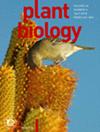The consequences of flower colour polymorphism on the reproductive success of a neotropical deceptive orchid
IF 3.6
3区 生物学
Q1 PLANT SCIENCES
引用次数: 0
Abstract

颜色多态性对新热带迷彩兰繁殖成功的影响。
具有欺骗性的植物常常表现出高水平的多态性。然而,花多态性与欺骗策略之间关系的基础仍不清楚。一种由蝴蝶传粉的新热带欺骗兰花,具有未被探索的种群内花色多态性。在这里,我们研究了这种多态性对其繁殖成功的影响。我们进行了田间和普通花园实验,旨在检测传粉媒介介导的选择强度和方向,并测试多种颜色变体的存在是否会增加物种的繁殖成功率。在野外,我们监测了两个种群在两个开花季节的植物繁殖成功率和花形态,并进行了选择梯度分析。在普通园林中,我们收集了具有相同和不同花色个体的栽培植物地块(即单一和多态地块),将它们暴露于传粉媒介并监测它们的繁殖成功率。在这两个地点,我们还监测了当地的传粉者群落。在野外,颜色变化表现相同,但我们发现形态分化和选择方向之间的一致性,这是非常动态的。在普通的花园中,单一和多态地块的表现也一样,随着时间的推移,繁殖成功率变化很大。我们还发现了一个高度多样化的传粉者群落。我们的研究结果表明,花的多态性是由多种因素共同维持的,包括不同传粉媒介的选择、不同传粉媒介偏好的分类交配和不同的表型遗传力。自然选择随时间和空间的变化而变化,表明传粉者和花的形态之间存在动态的相互作用。
本文章由计算机程序翻译,如有差异,请以英文原文为准。
求助全文
约1分钟内获得全文
求助全文
来源期刊

Plant Biology
生物-植物科学
CiteScore
8.20
自引率
2.60%
发文量
109
审稿时长
3 months
期刊介绍:
Plant Biology is an international journal of broad scope bringing together the different subdisciplines, such as physiology, molecular biology, cell biology, development, genetics, systematics, ecology, evolution, ecophysiology, plant-microbe interactions, and mycology.
Plant Biology publishes original problem-oriented full-length research papers, short research papers, and review articles. Discussion of hot topics and provocative opinion articles are published under the heading Acute Views. From a multidisciplinary perspective, Plant Biology will provide a platform for publication, information and debate, encompassing all areas which fall within the scope of plant science.
 求助内容:
求助内容: 应助结果提醒方式:
应助结果提醒方式:


